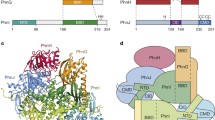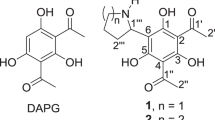Abstract
The catabolism of phosphonates (Phn) by Campylobacter spp. was investigated employing nuclear magnetic resonance spectroscopy and cell culture techniques. The bacteria were capable of cleaving the Phn bonds of different compounds, including α-aminomethylphosphonate, phosphonoacetate and phenylphosphonate (PhePhn). The kinetic parameters of these activities were determined in vivo in intact cells and in situ in whole-cell lysates. Cleavage of Phn-bearing compounds was associated with the cell-wall and cytosolic fractions. Results from substrate competition experiments suggested that at least two enzyme activities appeared to be involved in the cleavage of carbon–phosphate (C–P) bonds. In silico analyses indicated that no genes orthologous to those encoding C–P bond-cleaving enzymes in other bacteria were present in the Campylobacter jejuni genome. In most bacteria studied, Phn catabolism is induced under conditions of phosphate limitation; however, in Campylobacter spp. these activities were expressed in cells grown in media rich in phosphate. In chemically defined media, PhePhn supported bacterial growth and proliferation at concentrations above 100 μM in the absence of phosphate. Thus, Phn utilisation may be a survival mechanism of Campylobacter spp. in milieux lacking sufficient phosphate. The expression of these enzyme activities in media abundant in phosphate suggested also that they may have other physiological roles.




Similar content being viewed by others
References
Baker AS, Ciocci MJ, Metcalf WW, Kim J, Babbitt PC, Wanner BL, Martin BM, Dunaway-Mariano D (1998) Insights into the mechanism of catalysis by the P–C bond-cleaving enzyme phosphonoacetaldehyde hydrolase derived from gene sequence analysis and mutagenesis. Biochemistry 37:9305–9315
Bardin S, Dan S, Osteras M, Finan TM (1996) A phosphate transport system is required for symbiotic nitrogen fixation by Rhizobium meliloti. J Bacteriol 178:4540–4547
Imazu K, Tanaka S, Kuroda A, Anbe Y, Kato J, Ohtake H (1998) Enhanced utilization of phosphonate and phosphite by Klebsiella aerogenes. Appl Environ Microbiol 64:3754–3758
Jiang W, Metcalf WW, Lee K-S, Wanner BL (1995) Molecular cloning, mapping, and regulation of Pho regulon genes for phosphonate breakdown by the phosphonatase pathway of Salmonella typhimurium. J Bacteriol 177:6411–6421
Kononova SV, Nesmenayanova MA (2002) Phosphonates and their degradation by microorganisms. Biochemistry (Moscow) 67:184–195
Kulakova AN, Kulakov LA, Akulenko NV, Ksenzenko VN, Hamilton JT, Quinn JP (2001) Structural and functional analysis of the phosphonoacetate hydrolase (phnA) gene region in Pseudomonas fluorescens 23F. J Bacteriol 183:3268–3275
Lee K-S, Metcalf WW, Wanner BL (1992) Evidence for two phosphonate degradative pathways in Enterobacter aerogenes. J Bacteriol 174:2501–2510
McGrath JW, Wisdom GB, McMullan G, Larkin MJ, Quinn JP (1995) The purification and properties of phosphonoacetate hydrolase, a novel carbon–phosphorus bond-cleavage enzyme from Pseudomonas fluorescens 23F. Eur J Biochem 234:225–230
McGrath JW, Hammerschmidt F, Quinn JP (1998) Biodegradation of phosphonomycin by Rhizobium huakuii PMY1. Appl Environ Microbiol 64:356–358
Metcalf WW, Wanner BL (1993) Mutational analysis of an Escherichia coli fourteen-gene operon for phosphonate degradation, using TnphoA′ elements. J Bacteriol 175:3430–3442
Ohtake H, Wu H, Imazu K, Anbe Y, Kato J, Kuroda A (1996) Bacterial phosphonate degradation, phosphite oxidation and polyphosphate accumulation. Resour Conserv Recycl 18:125–134
Parker GF, Higgins TP, Hawkes T, Robson RL (1999) Rhizobium (Sinorhizobium) meliloti phn genes: characterization and identification of their protein products. J Bacteriol 181:389–395
Parkhill J, Wren BW, Mungall K, Ketley JM, Churcher C, Basham D, Chillingworth T, Davies, R.M, Feltwell T, Holroyd S, Jagels K, Karlyshev AV, Moule S, Pallen MJ, Penn CW, Quail MA, Rajandream MA, Rutherford KM, van Vliet AH, Whitehead S, Barrell BG (2000) The genome sequence of the food-borne pathogen Campylobacter jejuni reveals hypervariable sequences. Nature 403:665–668
Quinn JP, McMullan G (1995) Carbon–arsenic bond cleavage by a newly isolated gram-negative bacterium, strain ASV2. Microbiology 141:721–725
Quinn JP, Peden JMM, Dick RE (1989) Carbon–phosphorus cleavage by gram-positive bacteria. Appl Microbiol Biotechnol 31:283–287
Schowanek D, Verstraete W (1990) Phosphonate utilization by bacterial cultures and enrichments from environmental samples. Biodegradation 1:43–53
Stevens, JB, de Luca NG, Beringer JE, Ringer JP, Yeoman KH, Johnston AW (2000) The purMN genes of Rhizobium leguminosarum and a superficial link with siderophore production. Mol Plant Microbe Interact 13:228–231
Stover CK, Pham XQ, Erwin AL, Mizoguchi SD, Warrener P, Hickey MJ, Brinkman FS, Hufnagle WO, Kowalik DJ, Lagrou M, Garber RL, Goltry L, Tolentino E, Westbrock-Wadman S, Yuan Y, Brody LL, Coulter SN, Folger KR, Kas A, Larbig K, Lim R, Smith K, Spencer D, Wong GK, Wu Z, Paulsen IT, Reizer J, Saier MH, Hancock RE, Lory S, Olson MV (2000) Complete genome sequence of Pseudomonas aeruginosa PA01, an opportunistic pathogen. Nature 406:959–964
Ternan NG, Quinn JP (1998) Phosphate starvation-independent 2-aminoethylphosphonic acid biodegradation in a newly isolated strain of Pseudomonas putida, NG2. Appl Microbiol 21:346–352
Ternan NG, Hamilton JT, Quinn JP (2000) Initial in vitro characterisation of phosphonopyruvate hydrolase, a novel phosphate starvation-independent, carbon–phosphorus bond cleavage enzyme in Burkholderia cepacia Pal6. Arch Microbiol 173:35–41
Wackett LP, Shames SL, Venditi CP, Walsh CT (1987) Involvement of the phosphate regulon and the psiD locus in carbon–phosphorus lyase activity of Escherichia coli K-12. J Bacteriol 169:710–717
Wanner BL (1994) Molecular genetics of carbon–phosphorus bond cleavage in bacteria. Biodegradation 5:175–184
Acknowledgements
This work was made possible by the support of the Australian Research Council and the Ramaciotti Foundations.
Author information
Authors and Affiliations
Corresponding author
Rights and permissions
About this article
Cite this article
Mendz, G.L., Mégraud, F. & Korolik, V. Phosphonate catabolism by Campylobacter spp.. Arch Microbiol 183, 113–120 (2005). https://doi.org/10.1007/s00203-004-0752-7
Received:
Revised:
Accepted:
Published:
Issue Date:
DOI: https://doi.org/10.1007/s00203-004-0752-7




